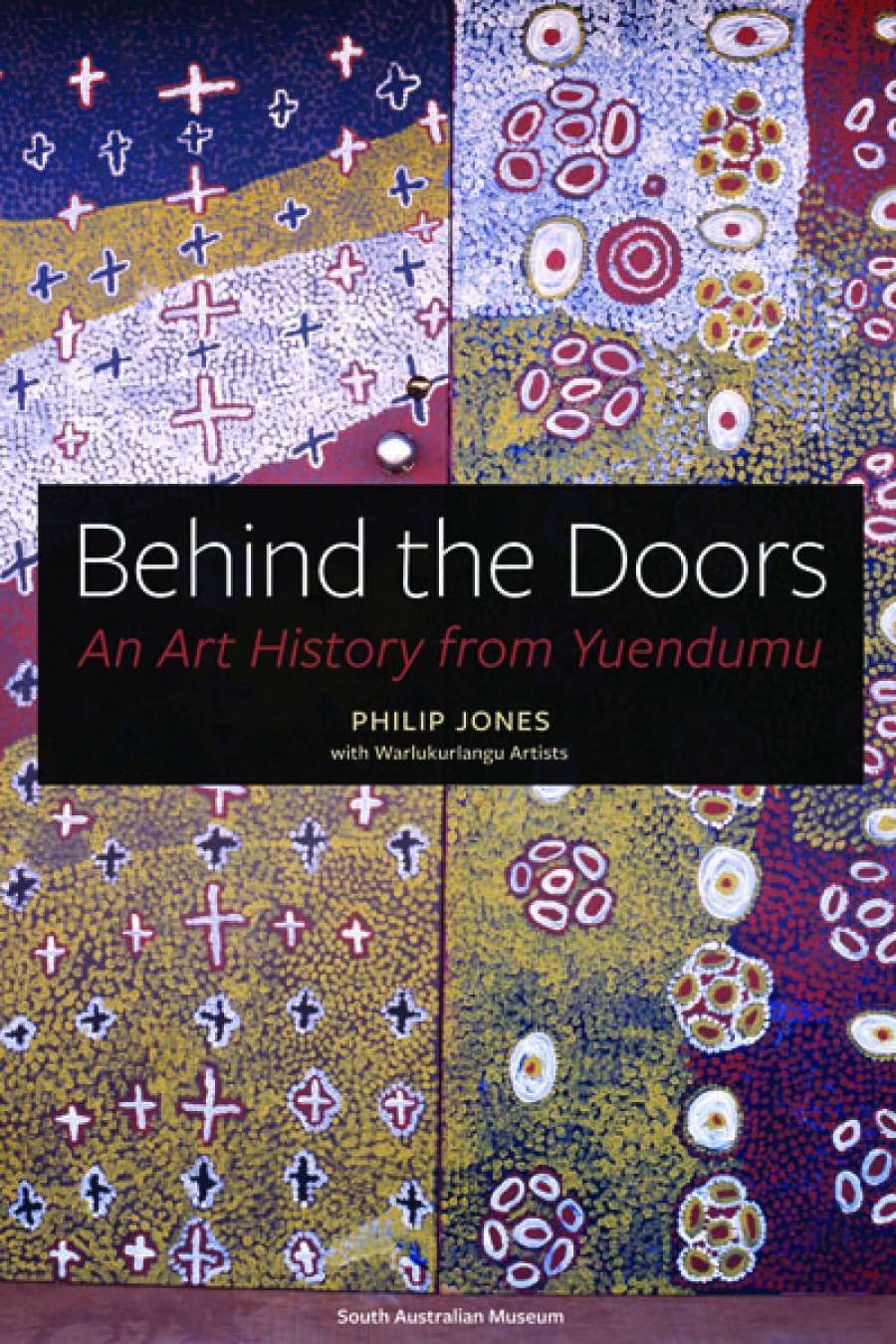
- Free Article: No
- Contents Category: Art
- Review Article: Yes
- Article Title: Odyssey in the desert
- Online Only: No
- Custom Highlight Text:
The painting of the Yuendumu doors in 1984 by Warlpiri artists, whose country is north-west of Alice Springs, represented an extraordinary moment in Australian art and modern art generally. In the 1980s some Aboriginal elders painted the doors in the Yuendumu School building to prompt students to show respect for their school and as a marker of their culture. It was the first time that they had painted using acrylics (not ochres), in colours never before used, to record the major stories of their community.
- Book 1 Title: Behind the Doors
- Book 1 Subtitle: An art history from Yuendumu
- Book 1 Biblio: Wakefield Press and the South Australian Museum, $44.95 pb, 212 pp
With the paintings on the doors being ravaged by the passage of time, and graffiti, a decision was made in 1996 to rescue the doors from destruction, and by agreement with the community they were removed to the South Australian Museum, and are now the subject of a book by Philip Jones, Senior Curator of Anthropology at the Museum.
 Door 6 after conservation
Door 6 after conservation
 Door 6 before conservation
Door 6 before conservation
Jones notes the unusual genesis of the doors project. A white art teacher at the Yuendumu school, Edith Coombe, was asked by the local storekeeper to paint a mural on the store wall to help beat the scourge of graffiti. Edith encouraged some local artists to undertake the work, and they painted some images on the store wall. At Edith’s further prompting, the painting of the school doors followed. After much deliberation, the school bus driver, Paddy Japaljarri Stewart, and a group of senior men decided to depict some of the ‘big’ stories of their community on the school doors, drawing on their practice from rock-shelter walls, and ground and body painting.
These epic works record timeless stories of attachment and journey, depicting the land and its secrets. In all, thirty doors were painted, of which about half are on public display at the South Australian Museum. But they were almost lost. The Department of Public Works turned up at the school with great zeal a few months after the doors were painted, ready to give the school (and the doors) a completely fresh coat of paint. Edith rushed to the rescue of the doors, and fortunately discouraged the painters from obscuring the precious works of art.
At various times, the value of the doors has been identified by museums and collectors. Soon after the doors were completed, the newly opened National Gallery of Australia offered the community $2,000 per door. This offer was rejected, as was an offer of $30,000 per door by a Melbourne dealer ten years later. The community eventually determined to ‘sell’ the doors to the South Australian Museum, with which it had enjoyed a long relationship, starting with visits from the Museum’s famous anthropologist Norman Tindale in the 1930s. The Museum has a significant legacy of association with desert Aboriginal communities, of which this book represents a continuing part. In return for the doors, the Museum bought the community two Toyota Landcruisers, and a fresh set of blank doors. Most importantly, the Museum also undertook to exhibit the doors.
The Museum then set about the removal of graffiti that covered the doors, such that it is undetectable today, but for one or two remaining scrawls to remind the viewing public of the history of the doors at Yuendumu and in particular their provenance as doors in use at a school.
 Door 13, Karnta-kurlu manu Warna-kurlu, painted by Larry Jungarrayi Spencer and Paddy Japaljarri Sims, 1984. Photographed at Yuendumu by G. Orkin, 1984. A72139, A72140, South Australian Museum
Door 13, Karnta-kurlu manu Warna-kurlu, painted by Larry Jungarrayi Spencer and Paddy Japaljarri Sims, 1984. Photographed at Yuendumu by G. Orkin, 1984. A72139, A72140, South Australian Museum
A number of the artists involved went on to have celebrated careers, with works represented in major galleries in Australia and internationally, such as Paddy Japaljarri Sims and Paddy Jupurrurla Nelson. To Jones, the artists who painted the doors were the last of the men in their community who truly ‘walked the land’.
Paddy Japaljarri Stewart stated in 1987 that the doors were painted with the community’s Dreaming to ensure that the children would learn the Laws of their community, ‘The children do not know them and they might become like white people, which we don’t want to happen.’
In this beautifully illustrated book, Jones begins to unlock some of the secrets of the doors. In their intricate detail, they record some of the great ancient stories of our land.


Comments powered by CComment